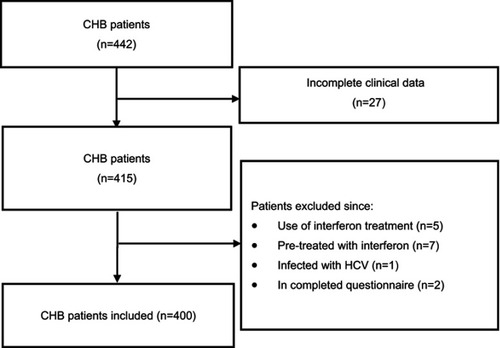Abstract
Aim
To evaluate fatigue in chronic hepatitis B patients and its related independent factors, as well as the relationship between fatigue and health-related quality of life (HRQoL).
Materials and methods
The study enrolled 400 patients who met the selection criteria, and their sociodemographic information was collected. The 36-item Short-Form Health Survey (SF-36) and Multidimensional fatigue inventory 20 (MFI-20) were adopted to evaluate HRQoL and fatigue level.
Results
Significant differences between the fatigue group and non-fatigue group were observed for the female proportion (p=0.021), height (p=0.003), and weight (p=0.010), with or without regular exercise (p=0.001). We further determined the dimensions of fatigue that were affected by these factors and found that male patients showed significantly lower results than female patients in terms of physical fatigue (p=0.048), mental fatigue (p=0.017), and reduced motivation (p=0.025). In patients who exercised regularly, the fatigue scores for the three dimensions of general fatigue (p<0.001), physical fatigue (p=0.046), and reduced activity (p=0.008) were significantly better than in those without exercise habits. Multivariate analysis was conducted, which suggested that only height and regular exercise habits were the independent factors affecting the patients’ fatigue levels. We further analyzed the relationship between quality of life and fatigue. With respect to physiological HRQoL, the average fatigue score of patients with high HRQoL was 41.91, which was significantly lower than that of patients with low physiological HRQoL (56.18, p<0.001). Moreover, the average fatigue score in patients with low psychological HRQoL was 55.25, which was significantly higher than that of patients with high psychological HRQoL (41.23, p<0.001). Correlation analysis showed that the physiological HRQoL and psychological HRQoL scores were negatively correlated with fatigue score (r = −0.639, p<0.001 and r= −0.655, p<0.001, respectively).
Conclusions
In this study, we found that the fatigue dimensions of chronic hepatitis B patients differed between various subpopulations. Height and regular exercise habits were the independent factors that affected the patients’ fatigue levels. Moreover, HRQoL was correlated with fatigue level. For patients with risk factors of fatigue, target intervention is advised in order to decrease fatigue and increase HRQoL.
Disclosure
The authors report no conflicts of interest in this work.

